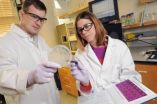(Press-News.org) When it comes to healing the terrible wounds of war, success may hinge on the first blood clot – the one that begins forming on the battlefield right after an injury.
Researchers exploring the complex stream of cellular signals produced by the body in response to a traumatic injury believe the initial response – formation of a blood clot – may control subsequent healing. Using that information, they're developing new biomaterials, including artificial blood platelets laced with regulatory chemicals that could be included in an injector device the size of an iPhone. Soldiers wounded in action could use the device to treat themselves, helping control bleeding, stabilizing the injury and setting the right course for healing.
Formation of "designer" blood clots from the artificial platelets would be triggered by the same factor that initiates the body's natural clotting processes. In animal models, the synthetic platelets reduced clotting time by approximately 30 percent, though the materials have not yet been tested in humans.
"The idea is to have on the battlefield technologies that would deliver a biomaterial capable of finding where the bleeding is happening and augmenting the body's own clotting processes," said Thomas Barker, an associate professor in the Wallace H. Coulter Department of Biomedical Engineering at Georgia Tech and Emory University. "Simultaneously, the material would help instruct the biochemistry and biophysics of the clot structure that would govern subsequent healing."
Barker is scheduled to present information on the research Friday, Feb. 15 in a briefing at the annual meeting of the American Association for the Advancement of Science (AAAS). The research has been sponsored in part by the National Institutes of Health (NIH), by the U.S. Department of Defense through the Center for Advanced Bioengineering for Soldier Survivability at Georgia Tech, and by an American Heart Association postdoctoral fellowship to Ashley Brown, a postdoctoral fellow working on the project.
After an injury, the most critical need is to stop the bleeding. But as traumatic injuries heal, they often produce significant scarring that is difficult to treat. Georgia Tech researchers are working on both sides of the problem, developing cell signaling techniques that may head off the formation of scars – as well as techniques for addressing the fibrosis that is often the long-term result. Beyond helping halt the bleeding, the synthetic platelets would deliver regulatory chemicals designed to prevent scarring.
"The blood clot actually ends up directing how the entire wound healing process is going to occur," Barker said. "The initial clot matrix instructs very specific cellular behaviors which have consequences for the next wave of cells that comes in to do specific jobs, which have consequences for the next wave of cells. If we can modify that initial clot, it can become the three-dimensional matrix needed to build the regenerated or repaired tissue."
The synthetic platelets, made from tiny structures known as hydrogels, could be injected into the bloodstream where they would circulate until activated by the body's own clotting processes. Once activated, the particles – which are about one micron in diameter – would change shape, converting to a thin film that would help seal wounds. To develop these hydrogels, Barker is collaborating with Andrew Lyon, a professor in Georgia Tech's School of Chemistry and Biochemistry.
The bloodstream contains proteins known as fibrinogen that are the precursors for fibrin, the polymer that provides the basic structure for natural blood clots. When they receive the right signals from a protein called thrombin, these precursors polymerize at the site of the bleeding. To prevent unintended activation of their synthetic platelets, the researchers use the same trigger.
The researchers followed a process known as molecular evolution to develop an antibody that could be attached to the hydrogels to cause their form to change when they encounter thrombin-activated fibrin. The resulting antibody has high affinity for the polymerized form of fibrin and low affinity for the precursor.
"We knew the molecule that we wanted and we knew the domains that were critical for recognition," Barker said. "The primary design concept was the ability to recognize an active, forming clot from the soluble, inactive precursor."
The artificial platelets have so far been tested in rats, and separately using in vitro simulated endothelial systems in the laboratory of Wilbur Lam, an assistant professor at Emory University in Atlanta. Though the work is a long way from a device that could be used on the battlefield, Barker envisions transitioning the research to a startup company that develop the technology to improve survivability for wounded soldiers.
"You could have it literally in the pocket of any soldier, who could pop it out when needed," Barker explained. "As the needle is extended, you would break the package of freeze-dried particles. The device would then be placed on the abdomen, where the particles would be injected into the bloodstream. They would circulate inactive until they encountered the initiation of clotting."
Once the bleeding was stopped, cytokines and anti-inflammatory compounds within the "designer" clot could help determine the phenotype that should be adopted by healing cells and regulate their behavior. That would set the stage for the subsequent healing process.
To help soldiers already suffering from the effects of fibrosis – the contraction of scarred tissue – the researchers are developing a polymer to which a natural peptide is attached. The peptide helps regulate the repair process that produces scars and could ultimately help reduce or reverse the effects of fibrosis. The technique has reversed the effects of pulmonary fibrosis in an animal model.
Though the research focuses on the needs of soldiers injured on the battlefield, many of the technologies could ultimately find civilian use. Because the artificial platelets would only activate when the encounter thrombin-activated fibrin, they could be used by emergency medical technicians treating patients in which internal bleeding is suspected, Barker said.
INFORMATION:
This research is supported by the National Institutes of Health (NIH) under contract R21EB013743 and by the U.S. Department of Defense (DoD) under contract W81XWH110306. The conclusions are those of the authors and do not necessarily represent the official views of the NIH or the DoD.
Artificial platelets could treat injured soldiers on the battlefield
Designer blood clots
2013-02-15
ELSE PRESS RELEASES FROM THIS DATE:
NIH study shows big improvement in diabetes control over past decades
2013-02-15
More people are meeting recommended goals in the three key markers of diabetes control, according to a study conducted and funded by the National Institutes of Health and the Centers for Disease Control and Prevention.
The report, published online February 15 in Diabetes Care, shows that, from 1988 to 2010, the number of people with diabetes able to meet or exceed all three of the measures that demonstrate good diabetes management rose from about 2 percent to about 19 percent. Each measure also showed substantial improvement, with over half of people meeting each individual ...
Climate change's costly wild weather consequences
2013-02-15
CHAMPAIGN, Ill. — Throughout 2012, the United States was battered by severe weather events such as hurricanes and droughts that affected both pocketbooks and livelihoods. Research suggests that in the coming years, U.S. five-day forecasts will show greater numbers of extreme weather events, a trend linked to human-driven climate change.
Donald Wuebbles, a professor of atmospheric sciences at the University of Illinois at Urbana-Champaign, will discuss extreme weather in a presentation Feb. 15 at the annual meeting of the American Association for the Advancement of Science ...
Scientists find promising new approach to preventing progression of breast cancer
2013-02-15
LA JOLLA, CA – February 15, 2013 – Doctors currently struggle to determine whether a breast tumor is likely to shift into an aggressive, life-threatening mode—an issue with profound implications for treatment. Now a group from The Scripps Research Institute (TSRI) has identified a mechanism through which mitochondria, the powerhouses of a cell, control tumor aggressiveness. Based on their findings, the team developed a simple treatment that inhibits cancer progression and prolongs life when tested in mice.
The research team, which describes its results February 15, 2013, ...
Study finds that 'Big Pharma' fails at self-policing ED drug advertising
2013-02-15
CHARLOTTE, N.C. –Feb. 14, 2013– The pharmaceutical industry's efforts to self-regulate its direct-to-consumer (DTC) advertising are "an industry-sponsored ruse," intended to deflect criticism and collectively block new Federal regulation, a study released today in the Journal of Health Politics, Policy and Law found.
The paper, "The Politics and Strategy of Industry Self-Regulation: The Pharmaceutical Industry's Principles for Ethical Direct-to-Consumer Advertising as a Deceptive Blocking Strategy," was written by Denis Arnold, Associate Professor of Management and Surtman ...
Avoiding virus dangers in 'domesticating' wild plants for biofuel use
2013-02-15
In our ongoing quest for alternative energy sources, researchers are looking more to plants that grow in the wild for use in biofuels, plants such as switchgrass.
However, attempts to "domesticate" wild-growing plants have a downside, as it could make the plants more susceptible to any number of plant viruses.
In a presentation at this year's meeting of the American Association for the Advancement of Science, Michigan State University plant biologist Carolyn Malmstrom said that when we start combining the qualities of different types of plants into one, there can be ...
Breast cancer risk prediction model for African American women underestimates risk
2013-02-15
(Boston) – A breast cancer risk prediction model developed for African Americans tends to underestimate risk in certain subgroups, according to a new study from the Slone Epidemiology Center (SEC) at Boston University. The model predicted estrogen receptor (ER)-negative breast cancer, which is a more aggressive form of breast cancer that disproportionately affects African American women, more poorly than ER-positive breast cancer.
The study, published online today in the Journal of the National Cancer Institute, was led by Deborah Boggs, ScD, postdoctoral associate at ...
Neuronal activity induces tau release from healthy neurons
2013-02-15
HEIDELBERG, 15 February 2013 – Researchers from King's College London have discovered that neuronal activity can stimulate tau release from healthy neurons in the absence of cell death. The results published by Diane Hanger and her colleagues in EMBO reports show that treatment of neurons with known biological signaling molecules increases the release of tau into the culture medi-um. The release of tau from cortical neurons is therefore a physiological process that can be regulated by neuronal activity.
Tau proteins stabilize microtubules, the long threads of polymers ...
University of Waterloo researchers propose breakthrough architecture for quantum computers
2013-02-15
WATERLOO, Ont. (Thursday, Feb. 14, 2013) A team of researchers at the University of Waterloo's Institute for Quantum Computing has proposed a new computational model that may become the architecture for a scalable quantum computer.
In a paper to be published in the journal Science this week, the research team of IQC Associate Professor Andrew Childs, post-doctoral fellow David Gosset and PhD student Zak Webb proposes using multi-particle quantum walks for universal computation. In a multi-particle quantum walk, particles live on the vertices of a graph and can move between ...
UTSW researchers identify new enzyme that acts as innate immunity sensor
2013-02-15
DALLAS – Feb. 15, 2013 – Two studies by researchers at UT Southwestern Medical Center could lead to new treatments for lupus and other autoimmune diseases and strengthen current therapies for viral, bacterial, and parasitic infections.
The studies identify a new enzyme that acts as a sensor of innate immunity – the body's first line of defense against invaders – and describe a novel cell signaling pathway. This pathway detects foreign DNA or even host DNA when it appears in a part of the cell where DNA should not be. In addition, the investigations show that the process ...
Researchers uncover new findings on genetic risks of Behçet's disease
2013-02-15
ANN ARBOR, Mich. — Researchers don't know the exact cause of Behçet's disease, a chronic condition that leads to oral and genital sores and serious complications such as blindness, but new research brings better understanding to what makes some people more susceptible to being affected.
In one of the most extensive genetic analyses of Behçet's disease, a University of Michigan-led, international team of researchers has identified novel gene variants in the inflammatory disorder and uncovered data that could apply to studies of other diseases. The results appear in the ...
LAST 30 PRESS RELEASES:
Deepest gas hydrate cold seep ever discovered in the arctic: International research team unveils Freya Hydrate Mounds at 3,640 m depth.
Integrating light and structure: Smarter mapping for fragile wetland ecosystems
ACA-SIM: A robust way to decode satellite signals over complex waters
Probiotics can restore gut microbiome in breastfed infants
AI could help predict nutrition risks in ICU patients, study finds
Federal EITC has unexpected result, researchers say – it decreases domestic violence
Researchers identify gene that calms the mind and improves attention in mice
Artificial metabolism turns waste CO2 into useful chemicals
Ancient sea anemone sheds light on animal cell type evolution
Begging gene leads to drone food
How climate policies that incentivize and penalize can drive the clean energy transition
Can community awareness campaigns in low-resource areas improve early diagnosis of colorectal cancer?
Stardust study resets how life’s atoms spread through space
Practical education: Clinical scenario-based program development
The impact of family dynamics on eating behaviour – how going home for Christmas can change how you eat
Tracing the quick synthesis of an industrially important catalyst
New software sheds light on cancer’s hidden genetic networks
UT Health San Antonio awarded $3 million in CPRIT grants to bolster cancer research and prevention efforts in South Texas
Third symposium spotlights global challenge of new contaminants in China’s fight against pollution
From straw to soil harmony: International team reveals how biochar supercharges carbon-smart farming
Myeloma: How AI is redrawing the map of cancer care
Manhattan E. Charurat, Ph.D., MHS invested as the Homer and Martha Gudelsky Distinguished Professor in Medicine at the University of Maryland School of Medicine
Insilico Medicine’s Pharma.AI Q4 Winter Launch Recap: Revolutionizing drug discovery with cutting-edge AI innovations, accelerating the path to pharmaceutical superintelligence
Nanoplastics have diet-dependent impacts on digestive system health
Brain neuron death occurs throughout life and increases with age, a natural human protein drug may halt neuron death in Alzheimer’s disease
SPIE and CLP announce the recipients of the 2025 Advanced Photonics Young Innovator Award
Lessons from the Caldor Fire’s Christmas Valley ‘Miracle’
Ant societies rose by trading individual protection for collective power
Research reveals how ancient viral DNA shapes early embryonic development
A molecular gatekeeper that controls protein synthesis
[Press-News.org] Artificial platelets could treat injured soldiers on the battlefieldDesigner blood clots




